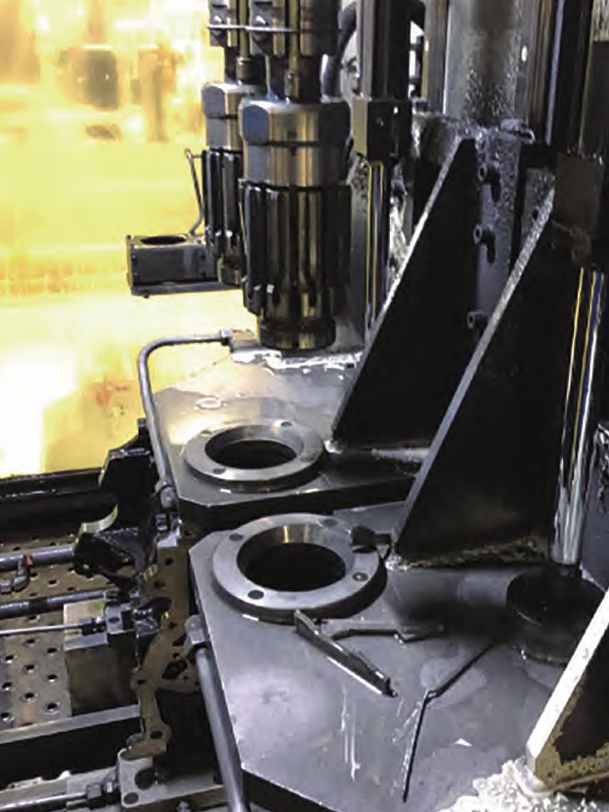This article systematically investigates the root causes of sand hole and slag hole defects in automotive brake drum castings and proposes targeted improvement measures. Through a combination of process optimization, mold design adjustments, and numerical simulation verification, the scrap rate due to these casting defects was reduced from 10% to 0.8%.
1. Casting Process Characteristics and Defect Manifestations
The brake drum casting (HT250 material) features complex geometry with critical functional surfaces including the braking band, end faces, and outer wall. The production process utilizes horizontal flask KW jolt-squeeze molding with the following key parameters:
| Parameter | Value |
|---|---|
| Casting Weight | 23 kg |
| Mold Size (Upper/Lower) | 1200×900×350 mm / 1200×900×250 mm |
| Molding Rate | 90 molds/hour |
| Compaction Pressure | 1.25 MPa |
The chemical composition requirements are critical for achieving proper mechanical properties:
| Element | Composition Range (%) |
|---|---|
| C | 3.15–3.35 |
| Si | 1.65–2.00 |
| Mn | 0.60–0.95 |
| Cr | 0.20–0.40 |
Defect distribution analysis revealed three primary failure modes:
- Slag holes at outer wall diameter (32%)
- Sand holes at end faces (45%)
- Mixed defects at braking band (23%)

2. Root Cause Analysis of Casting Defects
The formation mechanisms of sand holes and slag holes can be modeled using fluid dynamics and mold-material interaction principles:
2.1 Mold-Pattern Interface Defects
The original pattern-plate interface design caused sand erosion during mold drawing. The interface gap (δ) and resultant sand carrying probability (P) follow:
$$ P = 1 – e^{-\lambda \cdot \delta^2} $$
Where λ represents the sand adhesion coefficient (0.25–0.35 for bentonite-bonded sand). Measurements showed δ ≤ 0.2 mm in critical areas, resulting in P ≥ 68%.
2.2 Gating System Limitations
The initial bottom-pouring system created turbulent flow conditions. The Reynolds number (Re) at the ingate reached:
$$ Re = \frac{\rho v d}{\mu} = \frac{7000 \times 1.2 \times 0.02}{0.004} = 42,000 $$
This turbulent flow (Re > 4000) caused both sand erosion and slag entrainment. The filtration efficiency (η) of fiber filters was only 62% compared to 89% for ceramic foam filters.
3. Process Optimization Strategy
The improvement program focused on three key areas:
3.1 Mold-Pattern Interface Optimization
- Increased root radius from R1 to R6
- 5 mm pattern embedding depth
- Surface roughness reduction to Ra ≤ 3.2 μm
3.2 Gating System Redesign
The optimized system features multi-stage velocity control:
| Section | Area Ratio | Flow Velocity (m/s) |
|---|---|---|
| Choke | 1.0 | 2.8–3.2 |
| Runner | 1.5 | 1.9–2.1 |
| Gate | 5.0 | 0.5–0.7 |
The velocity reduction follows the continuity equation:
$$ v_2 = v_1 \times \frac{A_1}{A_2} $$
3.3 Filtration System Upgrade
Implementation of 65×65×15 mm ceramic foam filters increased slag capture efficiency:
$$ \eta_{new} = 1 – (1 – \eta_{filter})(1 – \eta_{trap}) = 1 – (0.11)(0.35) = 96.15\% $$
4. Numerical Simulation Verification
MAGMASOFT® simulations confirmed the improvements:
| Parameter | Original | Optimized |
|---|---|---|
| Maximum Velocity (m/s) | 1.2 | 0.7 |
| Turbulence Index | 0.85 | 0.32 |
| Filling Time (s) | 4.2 | 5.8 |
5. Production Validation Results
Implementation results showed significant quality improvement:
| Month | Production (pcs) | Defect Rate (%) |
|---|---|---|
| March | 7,272 | 1.18 |
| April | 12,228 | 0.83 |
| May | 2,560 | 0.08 |
| June | 2,541 | 0.20 |
The total defect rate reduction follows the exponential decay model:
$$ R(t) = R_0 \cdot e^{-kt} $$
Where k = 0.35 month⁻¹, indicating continuous process improvement.
6. Conclusion
This study demonstrates that systematic analysis of casting defect formation mechanisms combined with numerical simulation can effectively resolve sand hole and slag hole issues. The key success factors include:
- Mold-pattern interface optimization reducing sand erosion probability by 82%
- Gating system redesign maintaining laminar flow (Re < 2000)
- Advanced filtration achieving 96% slag removal efficiency
The methodology provides a scientific approach for solving similar casting defect challenges in automotive components, particularly for safety-critical parts requiring high structural integrity.
